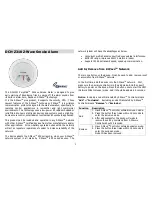
9
GB
FR
IT
PL
DE
• Fit the terminal back inside the detector
(Fig. 6)
.
• Mount the detector on its base and turn until it clicks into place
(Fig. 10A)
. Perform a function test (see Test/Maintenance).
• In the event of any technical problems, contact the manufacturer or
your local distributor.
Note:
• Mount the detector on the ceiling in the centre of the room
• Do not install smoke detectors in bathrooms (high ambient humidity),
garages (exhaust fumes), draughty environments or lofts
(Fig. 1 and 4)
.
• On roofs which slope by more than 30° the detector can be mounted
on the pitched roof area
(Fig. 4)
.
• Maintain a distance of 50 cm from walls, ceiling joints (beams) and
lights
(Fig. 2 and 3)
.
• Rooms of over 60 m² and corridors longer than 10 m require several
detectors
(Fig. 1)
.
• Maintain a distance of 4 m from open fireplaces and cookers.
• A central power supply or remote powering is not permitted. Each
detector needs to be powered by its own battery fitted into the battery
compartment.
Test/Maintenance
The detector can be fully tested using the LED test button
(Fig. 10A)
:
battery test, electronic smoke chamber test and pulsating electronics
test. Perform a test at least once a year and every time you replace
the batteries. Press the test button (for up to 20 seconds) until a
loud, pulsating alarm signal (c. 85 dB) can be heard. The test alarm
automatically resets itself a few seconds after the test button has
been released. When necessary (around twice a year), wipe the device
with a clean, dry cloth and clean the outside with a vacuum cleaner.
The device automatically performs a test. It tests the evaluation unit
and the voltage and internal resistance of the battery approx. every
45 seconds. The red LED flashes briefly
(Fig. 10A)
to indicate that this
test is being performed. If the 9 V battery power supply falls below a
certain value, the detector will emit an audible signal (approx. every
45 seconds) approx. 30 days before the battery needs to be replaced
(see Installation/Assembly/Connection). The life of a battery is highly
dependent on, among other things, local conditions, for example
temperature, temperature fluctuations, humidity and the number of
test alarms/alarms. Alkaline: approx. 2–3 years. Lithium: up to approx.
10 years. The use of rechargeable batteries is not permitted. Test the
equipment each time after replacing the battery. If the device is faulty,
the red LED will flash approx. every 45 seconds alternately with the
audible signal. This indicates that the detector needs to be replaced.
When an alarm is triggered, the detector automatically resets itself if
there are no longer any particles in the smoke chamber. The detector
can also be switched off manually by removing the battery.
Note:
• For networked devices: The flat battery signal is only indicated by the
device in question. It is not relayed to the other networked devices.
• For networked devices: When testing a device using the LED test
button
(Fig. 10A)
, the alarm signal will be emitted by all networked
devices, i.e. as in the case of a real alarm, a pulsating alarm signal
(of limited duration) will be emitted and the red LED
(Fig. 10A)
will
flash on the tested device, at the same time as the alarm signal. The
other devices will also emit a pulsating alarm signal, but their red
LEDs will not flash.
• Excessive concentrations of dust, steam or other foreign bodies
inside the smoke chamber can trigger false alarms.
Notes regarding batteries and battery packs
Used batteries must not be disposed of as unsorted household
waste. Used batteries must be recycled and may be returned
free-of-charge to the place of sale. Batteries contain substances
which are harmful to the environment and to human health and must
therefore be disposed of correctly.






































